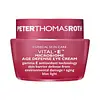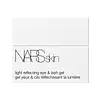What's inside
What's inside
 Key Ingredients
Key Ingredients

 Benefits
Benefits

 Concerns
Concerns

 Ingredients Side-by-side
Ingredients Side-by-side

Water
Skin ConditioningGlycerin
HumectantDimethicone
EmollientMethyl Trimethicone
Skin ConditioningButylene Glycol
HumectantCaprylyl Methicone
Skin ConditioningCeresin
Emulsion StabilisingDimethicone/PEG-10/15 Crosspolymer
Lauryl PEG-9 Polydimethylsiloxyethyl Dimethicone
Skin ConditioningAstrocaryum Tucuma Seed Butter
EmollientMicrocrystalline Wax
Emulsion StabilisingCaffeine
Skin ConditioningDimethylmethoxy Chromanol
AntioxidantTocopherol
AntioxidantBacillus
Skin ConditioningYeast Beta-Glucan
Skin ConditioningPalmitoyl Tripeptide-5
Skin ConditioningSilybum Marianum Seed Extract
Skin ConditioningAcetyl Heptapeptide-4
HumectantCeramide NP
Skin ConditioningSodium Hyaluronate
HumectantHedychium Coronarium Root Extract
MaskingSodium PCA
HumectantEclipta Prostrata Extract
Skin ConditioningDunaliella Salina Extract
Skin ConditioningPanthenol
Skin ConditioningMelia Azadirachta Leaf Extract
Skin ConditioningUndaria Pinnatifida Extract
Skin ConditioningInulin
Skin ConditioningMoringa Oleifera Seed Oil
EmollientPhenoxyethanol
PreservativeParaffin
PerfumingPotassium Sorbate
PreservativeMannitol
HumectantCellulose
AbsorbentDipropylene Glycol
HumectantSodium Benzoate
MaskingSodium Citrate
BufferingHydroxypropyl Methylcellulose
Emulsion StabilisingCitric Acid
BufferingEthylhexylglycerin
Skin ConditioningPantolactone
HumectantCaprylyl Glycol
EmollientMica
Cosmetic ColorantWater, Glycerin, Dimethicone, Methyl Trimethicone, Butylene Glycol, Caprylyl Methicone, Ceresin, Dimethicone/PEG-10/15 Crosspolymer, Lauryl PEG-9 Polydimethylsiloxyethyl Dimethicone, Astrocaryum Tucuma Seed Butter, Microcrystalline Wax, Caffeine, Dimethylmethoxy Chromanol, Tocopherol, Bacillus, Yeast Beta-Glucan, Palmitoyl Tripeptide-5, Silybum Marianum Seed Extract, Acetyl Heptapeptide-4, Ceramide NP, Sodium Hyaluronate, Hedychium Coronarium Root Extract, Sodium PCA, Eclipta Prostrata Extract, Dunaliella Salina Extract, Panthenol, Melia Azadirachta Leaf Extract, Undaria Pinnatifida Extract, Inulin, Moringa Oleifera Seed Oil, Phenoxyethanol, Paraffin, Potassium Sorbate, Mannitol, Cellulose, Dipropylene Glycol, Sodium Benzoate, Sodium Citrate, Hydroxypropyl Methylcellulose, Citric Acid, Ethylhexylglycerin, Pantolactone, Caprylyl Glycol, Mica
Water
Skin ConditioningDimethicone
EmollientButylene Glycol
HumectantGlycerin
HumectantDipropylene Glycol
HumectantPolyglyceryl-3 Polydimethylsiloxyethyl Dimethicone
Skin ConditioningCaprylyl Methicone
Skin ConditioningPolymethylsilsesquioxane
Lauroyl Lysine
Skin ConditioningPropanediol
SolventTrehalose
HumectantCamellia Japonica Flower Extract
EmollientDunaliella Salina Extract
Skin ConditioningTocopherol
AntioxidantDimethicone/Polyglycerin-3 Crosspolymer
CleansingSaccharide Isomerate
HumectantCitric Acid
BufferingSodium Citrate
BufferingPalmitoyl Tripeptide-5
Skin ConditioningPanthenol
Skin ConditioningSodium Hyaluronate
HumectantEthylhexylglycerin
Skin ConditioningPantolactone
HumectantSodium Chloride
MaskingHydrogenated Polyisobutene
EmollientPhytosteryl/Octyldodecyl Lauroyl Glutamate
Skin ConditioningEthylhexyl Palmitate
EmollientTrihydroxystearin
Skin ConditioningGlucomannan
Skin ConditioningPEG-8/Smdi Copolymer
Xanthan Gum
EmulsifyingSodium Metaphosphate
BufferingSilica
AbrasiveGold
Cosmetic ColorantAcetyl Hydroxyproline
EmollientArginine/Lysine Polypeptide
Skin ConditioningPhenoxyethanol
PreservativeSodium Benzoate
MaskingPotassium Sorbate
PreservativeSodium Metabisulfite
AntioxidantWater, Dimethicone, Butylene Glycol, Glycerin, Dipropylene Glycol, Polyglyceryl-3 Polydimethylsiloxyethyl Dimethicone, Caprylyl Methicone, Polymethylsilsesquioxane, Lauroyl Lysine, Propanediol, Trehalose, Camellia Japonica Flower Extract, Dunaliella Salina Extract, Tocopherol, Dimethicone/Polyglycerin-3 Crosspolymer, Saccharide Isomerate, Citric Acid, Sodium Citrate, Palmitoyl Tripeptide-5, Panthenol, Sodium Hyaluronate, Ethylhexylglycerin, Pantolactone, Sodium Chloride, Hydrogenated Polyisobutene, Phytosteryl/Octyldodecyl Lauroyl Glutamate, Ethylhexyl Palmitate, Trihydroxystearin, Glucomannan, PEG-8/Smdi Copolymer, Xanthan Gum, Sodium Metaphosphate, Silica, Gold, Acetyl Hydroxyproline, Arginine/Lysine Polypeptide, Phenoxyethanol, Sodium Benzoate, Potassium Sorbate, Sodium Metabisulfite
Ingredients Explained
These ingredients are found in both products.
Ingredients higher up in an ingredient list are typically present in a larger amount.
Butylene Glycol (or BG) is used within cosmetic products for a few different reasons:
Overall, Butylene Glycol is a safe and well-rounded ingredient that works well with other ingredients.
Though this ingredient works well with most skin types, some people with sensitive skin may experience a reaction such as allergic rashes, closed comedones, or itchiness.
Learn more about Butylene GlycolCaprylyl Methicone is a type of silicone.
It helps soften and soothe the skin by creating a thin film on top. This film helps trap moisture, keeping your skin hydrated.
Citric Acid is an alpha hydroxy acid (AHA) naturally found in citrus fruits like oranges, lemons, and limes.
Like other AHAs, citric acid can exfoliate skin by breaking down the bonds that hold dead skin cells together. This helps reveal smoother and brighter skin underneath.
However, this exfoliating effect only happens at high concentrations (20%) which can be hard to find in cosmetic products.
Due to this, citric acid is usually included in small amounts as a pH adjuster. This helps keep products slightly more acidic and compatible with skin's natural pH.
In skincare formulas, citric acid can:
While it can provide some skin benefits, research shows lactic acid and glycolic acid are generally more effective and less irritating exfoliants.
Most citric acid used in skincare today is made by fermenting sugars (usually from molasses). This synthetic version is identical to the natural citrus form but easier to stabilize and use in formulations.
Read more about some other popular AHA's here:
Learn more about Citric AcidDimethicone is a type of synthetic silicone created from natural materials such as quartz.
What it does:
Dimethicone comes in different viscosities:
Depending on the viscosity, dimethicone has different properties.
Ingredients lists don't always show which type is used, so we recommend reaching out to the brand if you have questions about the viscosity.
This ingredient is unlikely to cause irritation because it does not get absorbed into skin. However, people with silicone allergies should be careful about using this ingredient.
Note: Dimethicone may contribute to pilling. This is because it is not oil or water soluble, so pilling may occur when layered with products. When mixed with heavy oils in a formula, the outcome is also quite greasy.
Learn more about DimethiconeDipropylene Glycol is a synthetically created humectant, stabilizer, and solvent.
This ingredient helps:
Dipropylene glycol is technically an alcohol, but it belongs to the glycol family (often considered part of the ‘good’ alcohols). This means it is hydrating and gentle on skin unlike drying solvent alcohols like denatured alcohol.
As a masking agent, Dipropylene Glycol can be used to cover the smell of other ingredients. However, it does not have a scent.
Studies show Dipropylene Glycol is considered safe to use in skincare.
Learn more about Dipropylene GlycolWe don't have a description for Dunaliella Salina Extract yet.
Ethylhexylglycerin (we can't pronounce this either) is commonly used as a preservative and skin softener. It is derived from glyceryl.
You might see Ethylhexylglycerin often paired with other preservatives such as phenoxyethanol. Ethylhexylglycerin has been found to increase the effectiveness of these other preservatives.
Glycerin is already naturally found in your skin. It helps moisturize and protect your skin.
A study from 2016 found glycerin to be more effective as a humectant than AHAs and hyaluronic acid.
As a humectant, it helps the skin stay hydrated by pulling moisture to your skin. The low molecular weight of glycerin allows it to pull moisture into the deeper layers of your skin.
Hydrated skin improves your skin barrier; Your skin barrier helps protect against irritants and bacteria.
Glycerin has also been found to have antimicrobial and antiviral properties. Due to these properties, glycerin is often used in wound and burn treatments.
In cosmetics, glycerin is usually derived from plants such as soybean or palm. However, it can also be sourced from animals, such as tallow or animal fat.
This ingredient is organic, colorless, odorless, and non-toxic.
Glycerin is the name for this ingredient in American English. British English uses Glycerol/Glycerine.
Learn more about GlycerinThis synthetic peptide is created from lysine, valine, and palmitic acid.
According to the manufacturer, in-vitro studies show tissue growth and collagen synthesis. Another in-vivo study found 60 volunteers saw a significant reduction in wrinkles after 84 days.
Due to its palmitic acid base, this peptide may not be fungal-acne safe.
Learn more about Palmitoyl Tripeptide-5Panthenol is a common ingredient that helps hydrate and soothe the skin. It is found naturally in our skin and hair.
There are two forms of panthenol: D and L.
D-panthenol is also known as dexpanthenol. Most cosmetics use dexpanthenol or a mixture of D and L-panthenol.
Panthenol is famous due to its ability to go deeper into the skin's layers. Using this ingredient has numerous pros (and no cons):
Like hyaluronic acid, panthenol is a humectant. Humectants are able to bind and hold large amounts of water to keep skin hydrated.
This ingredient works well for wound healing. It works by increasing tissue in the wound and helps close open wounds.
Once oxidized, panthenol converts to pantothenic acid. Panthothenic acid is found in all living cells.
This ingredient is also referred to as pro-vitamin B5.
Learn more about PanthenolPantolactone is a synthetically created humectant.
As a humectant, Pantolactone helps draw moisture to the skin. It can help add hydration to your skin.
Phenoxyethanol is a preservative that has germicide, antimicrobial, and aromatic properties. Studies show that phenoxyethanol can prevent microbial growth. By itself, it has a scent that is similar to that of a rose.
It's often used in formulations along with Caprylyl Glycol to preserve the shelf life of products.
Potassium Sorbate is a preservative used to prevent yeast and mold in products. It is commonly found in both cosmetic and food products.
This ingredient comes from potassium salt derived from sorbic acid. Sorbic acid is a natural antibiotic and effective against fungus.
Both potassium sorbate and sorbic acid can be found in baked goods, cheeses, dried meats, dried fruit, ice cream, pickles, wine, yogurt, and more.
You'll often find this ingredient used with other preservatives.
Learn more about Potassium SorbateSodium Benzoate is a preservative. It's used in both cosmetic and food products to inhibit the growth of mold and bacteria. It is typically produced synthetically.
Both the US FDA and EU Health Committee have approved the use of sodium benzoate. In the US, levels of 0.1% (of the total product) are allowed.
Sodium benzoate works as a preservative by inhibiting the growth of bacteria inside of cells. It prevents the cell from fermenting a type of sugar using an enzyme called phosphofructokinase.
It is the salt of benzoic acid. Foods containing sodium benzoate include soda, salad dressings, condiments, fruit juices, wines, and snack foods.
Studies for using ascorbic acid and sodium benzoate in cosmetics are lacking, especially in skincare routines with multiple steps.
We always recommend speaking with a professional, such as a dermatologist, if you have any concerns.
Learn more about Sodium BenzoateSodium Citrate is the sodium salts of citric acid. In skincare, it is used to alter pH levels and acts as a preservative.
Its main functions are to maintain the pH of a product and neutralize metal ions.
The acidity of our skin is maintained by our glands and skin biome; normal pH level of skin is slightly acidic (~4.75-5.5).
Being slightly acidic allows our skin to create an "acid mantle". This acid mantle is a thin barrier that protects our skin from bacteria and contaminants.
Learn more about Sodium CitrateSodium Hyaluronate is hyaluronic acid's salt form. It is commonly derived from the sodium salt of hyaluronic acid.
Like hyaluronic acid, it is great at holding water and acts as a humectant. This makes it a great skin hydrating ingredient.
Sodium Hyaluronate is naturally occurring in our bodies and is mostly found in eye fluid and joints.
These are some other common types of Hyaluronic Acid:
Learn more about Sodium HyaluronateTocopherol (also known as Vitamin E) is a common antioxidant used to help protect the skin from free-radicals and strengthen the skin barrier. It's also fat soluble - this means our skin is great at absorbing it.
Vitamin E also helps keep your natural skin lipids healthy. Your lipid skin barrier naturally consists of lipids, ceramides, and fatty acids. Vitamin E offers extra protection for your skin’s lipid barrier, keeping your skin healthy and nourished.
Another benefit is a bit of UV protection. Vitamin E helps reduce the damage caused by UVB rays. (It should not replace your sunscreen). Combining it with Vitamin C can decrease sunburned cells and hyperpigmentation after UV exposure.
You might have noticed Vitamin E + C often paired together. This is because it is great at stabilizing Vitamin C. Using the two together helps increase the effectiveness of both ingredients.
There are often claims that Vitamin E can reduce/prevent scarring, but these claims haven't been confirmed by scientific research.
Learn more about TocopherolWater. It's the most common cosmetic ingredient of all. You'll usually see it at the top of ingredient lists, meaning that it makes up the largest part of the product.
So why is it so popular? Water most often acts as a solvent - this means that it helps dissolve other ingredients into the formulation.
You'll also recognize water as that liquid we all need to stay alive. If you see this, drink a glass of water. Stay hydrated!
Learn more about Water